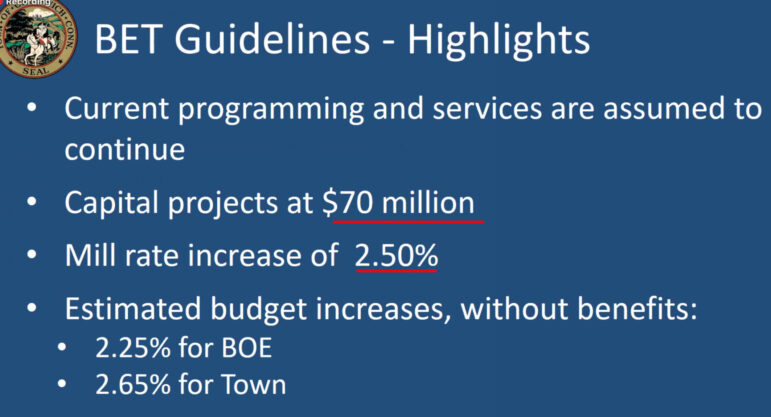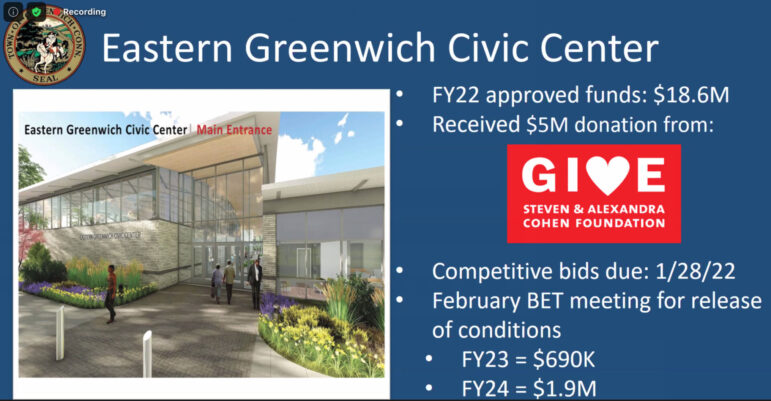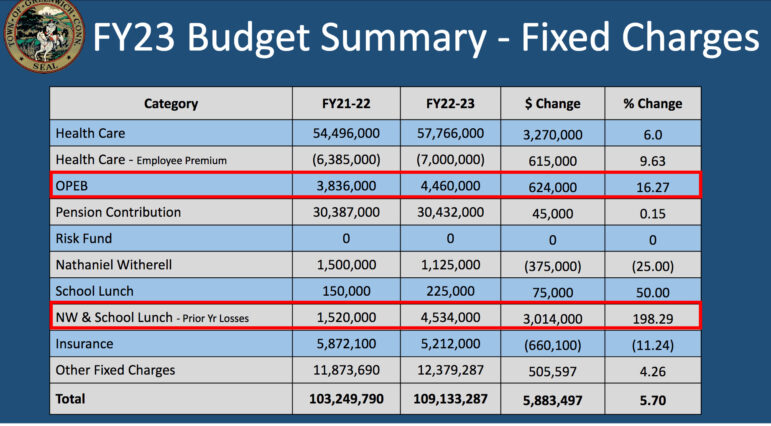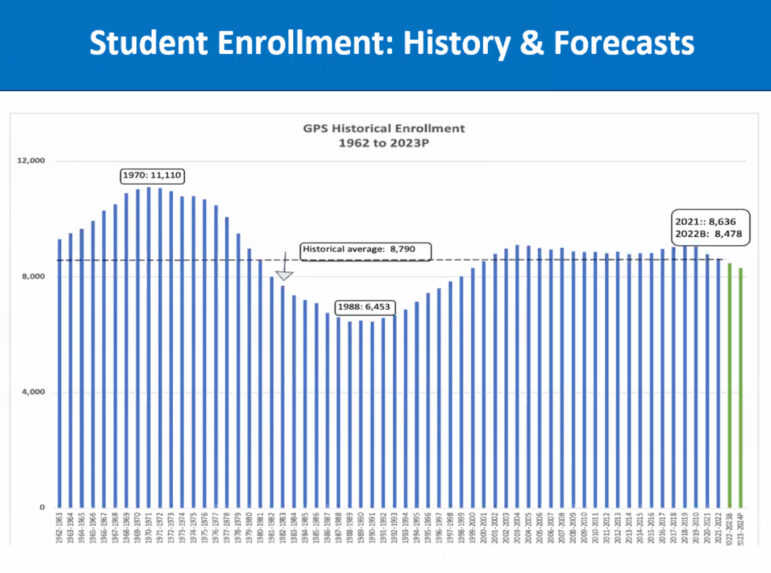On Tuesday Greenwich First Selectman Fred Camillo unveiled a $464 million budget before the BET budget committee.
Camillo proposed $84million in capital projects, but noted that with $8 million in grants and without $8 million for Western Middle School soil remediation, that could be reduced to $70 million.
Camillo said he was assuming a mill rate increase of 2.4%, though the mill rate is not set until May.
He said assuming a mill rate increase from 11.5 to 11.868, a 2.4% increase would be just under the guidelines. A taxpayer with a home valued at $1million would have a $278 increase in property taxes.

Estimated budget increases, without benefits, are 2.25% for BOE and 2.65% for the town.
Camillo said the American Resource Plan represented a great opportunity for Greenwich, which expects to receive almost $41million in funds: over $31 million for the town and $9.5 million for the schools.
Camillo said he envisioned ARP funds in four buckets: affordable housing, indoor air quality for critical town infrastructure, storm water and sewer, and community non profits.
“The $87 million in capital will jump out at you,” Camillo said. “It’s $17 million over the guidelines, but we do have roughly $8 million in the form of grants. Also, we put back $8 million that wasn’t in the budget for the WMS fields, which can be pushed back.”
Neighborhood improvements proposed to be funded include Byram traffic safety improvements ($300,000), Glenville center neighborhood improvements ($500,000), Old Greenwich streetscape ($500,000), Cos Cob neighborhood sidewalks ($400,000), Shore Road sidewalks ($750,000), and soil and remediation at GHS ($12 million) and Western Middle School ($8 million).


Camillo’s budget also includes $100,000 to evaluate a remake Roger Sherman Baldwin Park. He said the Parks & Rec garage sits on very valuable land.
“We think this is a very poor use of a great asset. We want to open it up, make it more green, establish more walking paths there, while still accommodating the great events we have there. It will mark the beginning of the resurgence and renovation of a brand new waterfront district.”
Camillo said there were two locations being evaluated to relocate the existing Parks activities housed the 50’s era building.
An RFP for a mixed use development project in the Island Beach parking lot has been issued. There is $100K in 2023 for evaluation, $1.3million in 2024 for design and relocation of parks operations and improvements to the park. Then, in 2025 there is $11.2 for construction of the park.
Camillo said his budget does not including funding for a new Hamill Skating Rink.
“We pushed the project out a year to allow the rink user committee to gain more public feedback and review the project scope,” he said.
Instead, there is $95,000 for the rink for fiscal year 2024 and $17 million in fiscal year 2025.

As for the Eastern Greenwich Civic Center, Camillo said competitive bids are due this week. In addition to the $5 million coming from Steven Cohen, there will be more naming opportunities within the building.
Capital Projects at Greenwich Schools
Camillo talked about cost avoidance, saying that at Julian Curtiss, for example, $111,000 for lighting/painting/paving could be avoided this year, since the whole school is scheduled for a nearly $30,000,000 construction in 2024.
At Old Greenwich, he questioned the $739,000 (ADA, lighting/paving/painting, and concrete) scheduled for 2024, which is the same year the school is scheduled for a $24,000,000 renovation.
At Riverside School he noted there was $2+ million in roof work scheduled three years before a $31.7million construction.
“If you’re building a home, would you replace your roof three years before?” he asked.
As for the operating budget, Camillo said the two biggest fixed charges were postemployment benefits, which are $3,836,000 this year and $4,460,000 in 2023, which is a 16.27% change. The town owned nursing home, the Nathaniel Witherell and school lunches increase 200% ($1.5m to $4.5m) based on prior year losses.
As for the Witherell, for which an RFP for management services has been issued, Camillo said the town’s financial year 2023 contribution would be $1.125 million.
“We don’t think losing $4, $5, $6 million $7 million a year is a way to conduct a business, no matter whether it is private industry or a municipality. This is a department and this is money that can be spent on lots of other things.”

After the presentation, John Mastronardi, director of the Witherell reached out to say the town owned nursing home was in the strongest position that it has been for many years.
“We are not only in the black, we are projecting revenue of $30 million for Fiscal Year 2022, with direct operating expenses at $21.3 million and indirect operating expenses of $5.2 million. We anticipate achieving a net profit for fiscal year 2022 of $1.1 million (excluding debt service).”
Headcount highlights include replacement of a Collective Bargaining Specialist with a consultant and elimination of one cook at the Senior Center. Four career firefighters were added in response to recommendation from the Matrix Consulting Group. Overall there was an increase in headcount of 2.14.
Board of Education
The Board of Education put forward a budget that is just over $176 million, for an increase of 2.82%, or just over $4.8 million, which superintendent Dr. Toni Jones described as slightly above guidance due to transportation bids coming in higher than expected.
After an RFP was issued, two bidders responded, and negotiations resulted in a 10.5% increase, which is a $1million increase year over year.
The vast majority of the budget goes to teacher salaries.
“We’ve worked hard to reduce the administrative percent of that pie. That is about 4% over two years ago, and now down to 2.7% is exactly the trend I like to see, with less your G&A and more people in front of your students,” said BOE chair Kathleen Stowe.
Stowe said at Julian Curtiss and Old Greenwich School the architectural and engineering money request was reduced to $1.5 million from $1.8 million.
At Central Middle School there is cost avoidance by moving up the construction dates, and the BOE is requesting $250,000 for feasibility work.
“This building has deteriorated more quickly,” Stowe said, noting it is expensive to maintain. She said at the reduced sq footage pricing, it would be likely possible to build a new CMS for something more reasonable than originally anticipated.
Dr. Jones talked about enrollment in public schools. She said that in 1998 the district enrollment bottomed out at 6,453.
Prior to that, in the 60s, enrollment rose and peaked in 1970 at 11,110.
This year there are 8,726 students enrolled.
“I’ve even had people ask, if we’re trending down enrollment, do you need to think about closing a school?” she said, adding that today the decline doesn’t look like the one that lead to the closure of a school in the early 80s.

Jones explained that even with a slight decline in enrollment, newer programs that bring demands for space inside buildings.
For example, the district’s preschool program has doubled and continues to be one of its fastest growing programs.
Preschool, which is required per the federal law, not only requires a lot of staff to run, but it also requires additional space in elementary schools.
Dr. Jones said three of the district’s elementary buildings were built before 1965, which is when Title I legislation began.
“That’s why we have reading specialists, and we have Title 1 Schools, but it takes space when you add those positions,” she said.
Also, she said special education law changed in 1974; space is needed for occupational therapists, physical therapists, speech teachers, special education teachers.
“We have changed a lot since 1974 and our buildings built in the 1930s and 1940s are not equipped for all those small spaces,” Jones said.
She said space is also needed for English Language Learners, which was reauthorized in 2015, as well as space for strings programs.
“We no longer just have one general music room,” she added.
Public Comment
During public comment the most of the feedback was in support of funds for Julian Curtiss School, Old Greenwich School and Central Middle School.
Mary Tobin talked about her son’s classroom at Old Greenwich School.
“As it is below sea level, and with rising storm surges year after year, every time we have a heavy storm, water seeps into his classroom and the bathroom floods with raw sewage,” she said, adding that the building also lacks accessibility, has outdated facilities without proper ventilation and has a lack of security sight lines from the front office.
Old Greenwich School principal Jen Bencivengo, who said at a time when moving air is vital for safety due to Covid, teachers and students were teaching and learning in much the same classroom conditions during the Spanish flu pandemic in 1918.
She said her building was constructed in 1902, and that funding for HVAC, ADA accessibility, flooding mitigation and a safe secure entrance had been put off.
“Even those days last week when the real feel was below 0° our teachers and students work in classrooms with windows open as their only ventilation option,” she added.
Bob Chaney said Central Middle School had many structural issues, including leaking walls and floors, and doors that can’t keep out the rain and snow in the cold weather. There are also major issues with the walls in the halls that connect the old and new part of the building. There is no boys locker room for the gymnasium.
He said nothing had been done structurally since 2017 when the master plan recommended the building be torn down down and replaced.
He said his child was on crutches earlier this year at Julian Curtiss, where there is no elevator. For many weeks Chaney had to get his son to school early and help him up the stairs to his classroom, and get to school early to help him back down the stairs at the end of the day.
He said because JC is centrally located, it is ideal an ideal location for a preschool program.
Lastly, he said, “It seems to me that the issues surrounding the school buildings are not being ignored. They’re being acknowledged and dismissed.”
Carey Bisbee, a parent at Riverside School said, “Delaying fiscal projects at OG and JC in the name of fiscal discipline yields the opposite result. Delays compounds the risks and vulnerabilities, as well as costs that comes from operating these buildings in their current state.”
Tom Healy, principal of Central Middle School, said he began giving interested stakeholders tours of the building in 2017.
“Though both Western Middle School and Eastern Middle School have had a full replacement of window walls in their buildings in the last six years, CMS has not had this project discussed to date, as it seems to be on hold while the fate of the entire building is debated.”
“From cracks in the exterior walls, to spaces between the interior walls and floors, exterior doors and windows with gaps, and a boys locker room and bathroom that are all but unusable,” Healy said.
Sam Sullivan, a parent at Old Greenwich School, said, “From the risk of sewage entering my child’s classroom, to the lack of sufficient ventilation, heating and cooling, the security issues and safety issues, the facilities don’t live up to a basic standard any parent should expect from their school.”
Randy Jachino, a JC magnet parent, urged the funds for that school. “As our town continues to get wealthier and wealthier on average, there seems to be an inverse relationship to money given to Greenwich Schools, education and infrastructure in particular.”
“The JC experience is not only behind the times as a learning environment, but we are relying on funding from parents to fund things at our school,” Jachino said. “We simply can’t keep up.”
Michael Chambers said he last walked the halls of JC in 1985. “Thirty five years later I can say every JC graduate has experienced learning in the same academic environment.”
He said that from 1995 to 2018, the building exceeded capacity before experiencing modest declines in recent years.
“It is with great disappointment that I hear that maybe that blip is a reason not to build a new Julian Curtiss School,” he said. “There are many cities and towns that have moved to forego infrastructure because their tax base doesn’t support. In Greenwich we have that capacity, but for some reason we continue to kick the can in the name of lower taxes.”
Kara Mendelsohn referenced the ceiling collapse last year at North Mianus School and the disruption, stress, loss of learing and expense involved in splitting up the students and sending half to another building in Stamford.
“We need to start taking care of long overdue capital projects now,” she said.
I95 Noise Remediation
Patty Roberts said the upcoming I95 project from exits 2-6 does not qualify for federal support for noise abatement, and therefore the town and state must join hands to solve the health issue.
Greg Piccinino said while property values were not his underlying motive, investing in noise remediation can increase municipal tax revenues and increase home values. In Tier 1 project noise barriers are funded federally at 90%, but the upcoming project on I95 in Greenwich did not meet the Tier 1 definition.
“The last time noise barriers were added for a reconstruction project was Darien in 2009,” she said. “This was a Tier 1 project.”
Sean Meyer from Cos Cob said noise pollution from I95 impacted health and learning and in addition to impairing hearing, increase stress levels, sleep disturbance and cardiovascular disease.
Joe Kantorski said the Byram Neighborhood Association had joined the Riverside Association and Neighborhood Citizens Against I95 Noise to help bring the town and the state together to help fund noise remediation measures.
“I urge you to support the First Selectman’s allocation for funds for noise remediation,” he said.
“More tires, more noise,” he said. “The number of tires on I95 has skyrocketed these last few years because of the increase in e-commerce sales. Nationwide, e-commerce grew 350% in 2020.”
He said I95 noise levels greatly exceed city and state ordinances.
“In some cases our noise levels are five or six times higher than legal limits,” Kantorski said, adding that the local organizations and the town are asking the CT Dept of Transportation to reduce I95 noise levels by 10 decibels.
Bike Routes
Anthony Moor, representing Pedal Greenwich, said that as more people work from home and look for sustainable healthy alternatives to driving, bicycles are becoming an important mode of local transportation.
He said unfortunately, shopping, train stations, schools and parks are all cut off and there are no safe bike lanes or bike routes in Greenwich.
Pedal Greenwich and the Bike Task Force are proposing several timely critical improvements in 2022. While they are not included in the annual budget they could likely be funded by existing town operating budgets and thorugh grants.
“No community has ever regretted building a bike or pedestrian pathway,” Moor said. “We’re asking you on the BET to help us address this much delayed quality of life issue before our streets seize up and become parking lots.”
Zoning Enforcement
Greenwich town planner Katie DeLuca spoke about head counts and her request for one additional full time and one part time zoning enforcement staff.
“Our resources are very limited so we have to triage the complaints that come in,” she said, adding that the department focuses on dangerous and overcrowded apartments.
“Without proper enforcement the best zoning regulations in the world don’t mean very much and community knows it,” she added. She asked that the item be restored to the proposed budget so she would have the opportunity to present her case to the full BET.
Francia Alvarez described P&Z as the heart and soul of Greenwich. She said the zoning enforcement office signs off on certificates of occupancy and investigates violations of the building zone regulations which may include illegal dwellings units, illegal uses of property, sign violations, site plan violations and coastal flood hazard violations.
“The Zoning Enforcement Officer is then asked to work with the person responsible for the violation to achieve compliance,” she said. “And now we have a building boom going on, with tear downs all over town and proposed 8-30g projects galore.”
“How much time would be required to inspect a seven story 8-30g building?” she asked.
Wynn McDaniel noted that in addition to new development in town and the recently approved reg on short term rentals, the ZEO’s cannot not keep up.
Fiscal Conservancy
Jane Sprung thanked the BET, under Republican leadership, for making fiscally prudent choices for schools and the town during the pandemic without sacrificing the quality of services and education for residents.
“I support the BET’s current modified pay-as-you-go debt policy. We don’t want our town overburdened with debt, like Hartford,” she cautioned, adding that economic conditions were still uncertain given new variants, inflation and an unemployment rate higher than national average.
She said given the town’s revauation, some residents will be hit with higher real estate taxes.
“And all residents are impacted by Hartford’s unfunded liabilities, zoning and educational mandates,” she added.
The BET budget committee will work with the town and school officials on the budget and additional public hearings will be held. They will approve a budget that will then go before the RTM for a vote in May.
Note: This article has been updated with a quote from John Mastronardi, director of the town owned nursing home, The Nathaniel Witherell.